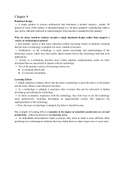Chapter 4
Dominant design
→ A single product or process architecture that dominates a product category—usually 50
percent or more of the market. A dominant design is a “de facto standard,” meaning that while it
may not be officially enforced or acknowledged, it has become a standard for the industry.
Why do many markets coalesce around a single dominant design rather than support a
variety of technological options?
→ One primary reason is that many industries exhibit increasing returns to adoption, meaning
that the more a technology is adopted, the more valuable it becomes.
→ Furthermore, as the technology is used, greater knowledge and understanding of the
technology accrue, which may then enable improvements both in the technology itself and in its
applications.
→ Finally, as a technology becomes more widely adopted, complementary assets are often
developed that are specialized to operate with the technology.
→ Two of the primary sources of increasing returns are:
● (1) learning effects and
● (2) network externalities.
Learning Effects
→ Ample empirical evidence shows that the more a technology is used, the more it is developed
and the more effective and efficient it becomes.
→ As a technology is adopted, it generates sales revenues that can be reinvested in further
developing and refining the technology.
→ As firms accumulate experience with the technology, they find ways to use the technology
more productively, including developing an organizational context that improves the
implementation of the technology.
→ Thus, the more a technology is adopted, the better it should become.
One example of learning effects is manifest in the impact of cumulative production on cost and
productivity—otherwise known as the learning curve.
→ As individuals and producers repeat a process, they learn to make it more efficient, often
producing new technological solutions that may enable them to reduce input costs or waste rates.
,Though learning curves are found in a wide range of organizational processes, there are
substantial differences in the rates at which organizations learn.
Prior Learning and Absorptive Capacity
→ A firm’s investment in prior learning can accelerate its rate of future learning by building the
firm’s absorptive capacity.
Absorptive capacity
→ The ability of an organization to recognize, assimilate, and utilize new knowledge.
→ Absorptive capacity refers to the phenomenon whereby as firms accumulate knowledge, they
also increase their future ability to assimilate information.
→ This knowledge base enables the firm to more rapidly assess the value of related new
materials, technologies, and methods.
→ The effects of absorptive capacity suggest that firms that develop new technologies ahead of
others may have an advantage in staying ahead.
Firms that forgo investment in technology development may find it very difficult or
expensive to develop technology in a subsequent period.
→ This explains, in part, why firms that fall behind the technology frontier find it so difficult to
catch up.
In sum, learning effects suggest that early technology offerings often have an advantage
because they have more time to develop and become enhanced than subsequent offerings.
Network externalities
→ Also termed positive consumption externalities, this is when the value of a good to a user
increases with the number of other users of the same or similar good.
, Installed base
→ The number of users of a particular good. For instance, the installed base of a particular video
game console refers to the number of those consoles that are installed in homes worldwide.
Complementary goods
→ Additional goods and services that enable or enhance the value of another good.
Firms can also attempt to influence the selection of a dominant design by building coalitions
around a preferred technology.
Government Regulation
→ In some industries, the consumer welfare benefits of having compatibility among
technologies have prompted government regulation, and thus a legally induced adherence to a
dominant design
The Result: Winner-Take-All Markets
→ A firm that is able to lock in its technology as the dominant design of a market usually earns
huge rewards and may dominate the product category through several product generations.
→ When a firm’s technology is chosen as a dominant design, not only does the firm have the
potential to earn near-monopoly rents in the short run, but the firm also is in a good position to
shape the evolution of the industry, greatly influencing what future generations of products will
look like.
Path dependency
→ When end results depend greatly on the events that took place leading up to the outcome. It is
often impossible to reproduce the results that occur in such a situation.






